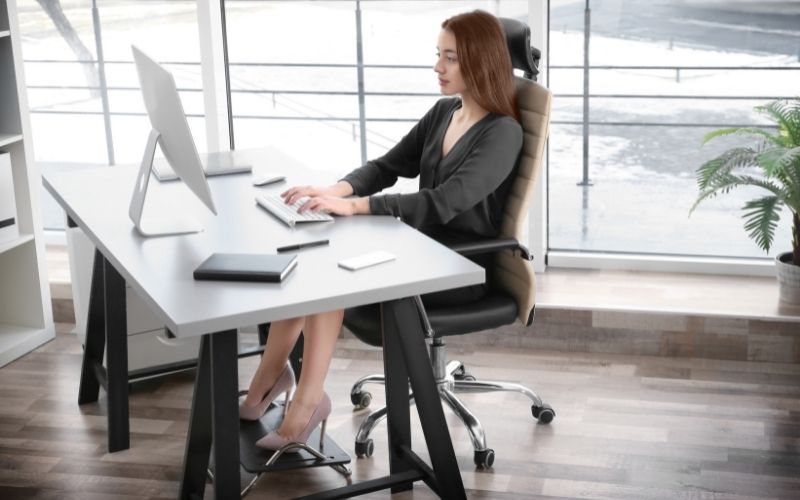People often complain about lower back pain after sitting at work all day. But another discomfort that results from prolonged sitting is neck pain.
Neck pain usually arises from the soft tissues, particularly the joints, ligaments, and muscles in and around the cervical spine. Often, it is caused by postural strain from sitting on the wrong chair.
Over time, it can cause headaches and may even lead to more serious health concerns. Therefore, you must address it early as soon as you experience signs of neck pain.
This article will talk about how a bad office chair causes neck pain and how you can reduce and avoid neck pain. We will also provide you a list of top-rated office chairs that might just solve your neck problems.
Sitting on a bad office chair can cause neck pain. Usually, the chair does not give you enough seat height adjustability, which leads to improper posture. Sitting slumped with your head forward can strain your neck and possibly cause injury. Neck pain, however, can be remedied through proper workplace ergonomics.
Table of Contents
Can a bad/poor ergonomic chair cause neck pain?

Yes, a poor ergonomic chair can cause neck pain.
A bad ergonomic chair might not be allowing you to maintain a proper sitting posture. It may lack the adjustments necessary for it to accommodate your body.
A good ergonomic office chair supports your low back to prevent slouching. Your low back should touch the lower part of your chair’s backrest, and the chair should support the natural curve of your spine.

A bad office chair often forces you to slump, causing your head to bend forward. When this happens, your neck takes pressure from the weight of your head, which is equivalent to a bowling ball – 10 to 12 pounds on average.
When your neck is bent, your head exerts even more force on it. It can lead to strained joints and muscles, and the pressure can also affect your breathing.
What should I do to reduce and avoid neck pain?
Neck pain caused by sitting for long periods is common, but it is avoidable. Plus, there are simple things you can do to reduce it.
Follow these tips next time you feel some discomfort in your neck:
Maintain a proper sitting posture.

When working at your desk, keep your head balanced directly over your spine. Sit with your buttocks far back in your chair and use a small pillow to support your lower back if needed.
Slanting your neck forward with your head in front of your shoulders is a poor sitting posture that contributes to neck pain. To avoid this, remember to tuck your chin inward.
Adjust your chair’s seat height. By doing this, you will allow your thighs to angle down slightly and avoid slumping your head and shoulder forward.
Also, when you’re seated, your feet should touch the ground. If adjusting your seat makes it impossible for you to keep your feet flat on the floor, use a stool or a footrest.
Do some neck exercises
When you start to feel aching or tightness in your neck, take a break and move around. Do some neck stretches. They can help relieve the stiffness by expanding or preserving your neck joints’ range of motion and elasticity.
Backward bending
Look upward and bring your head backward while keeping your back and shoulder in place. Stretch your head as far back as possible and hold it for five seconds before returning to a neutral position.
Forward bending
Tuck your chin inward and bend your head forward as far as you can. Hold the position for five seconds before coming back to neutral.
Side-to-side bending
Bend your head slowly to one side, bringing your left ear toward your left shoulder, hold it for five seconds, and come back to neutral. Repeat it on the other side.
Neck rotation
Slowly rotate your head to the left at an angle that feels comfortable, and hold the stretch for five seconds before coming back to neutral. Repeat on the other side.
Get an office chair with adjustable armrests or get rid of them.

Armrests that are too high can strain your neck and shoulder muscles.
Office chairs with fixed armrests can put pressure on your neck by positioning your elbows too high.
Try getting rid of the armrests so your neck and shoulder muscles can relax, or upgrade to an office chair with adjustable armrests.
If you are experiencing chronic neck pain, consult your doctor immediately.
With regards to neck pain, office chairs are preventive, not curative. If you feel that your neck pain is getting worse, it’s best to consult your doctor.
5 Good Office Chairs for Neck Pain
People usually shop for office chairs with excellent lower back support, but neck pain is nearly as common. Fortunately, many chairs in the market can help address it.
Below are five of the best office chairs that are great for neck pain:
Steelcase Gesture (with an added headrest)
- Connect fabric is 100% polyester
- Wheels for carpet flooring
- Ergonomic chair – features include adjustable seat depth, fully adjustable arms, adjustable lumbar, pneumatic...
The Steelcase Gesture is an iconic chair for many reasons. It is versatile, highly customizable, offers incredible support, and has many adjustments that guarantee comfort.
The Gesture’s stand-out feature is that its height and angle are adjustable so that you can lean forward or back while the chair cradles your neck. Whether you’re reclining or sitting upright, the headrest comes into play and supports your head and neck all the way.
Many Gesture owners report that they no longer feel fatigued after a long day at work and that their neck pain has subsided since using the chair.
Raynor Ergohuman (formerly Eurotech)
Often referred to as an excellent alternative to the pricier Herman Miller Aeron, the Raynor Ergohuman packs a punch. It is a high-back mesh ergonomic office chair that has excellent support, breathability, and adjustable features.
Its best feature is perhaps the headrest. It is height-adjustable, it pivots left and right, and it has a tilt adjustment and locking mechanism that can support your head and neck while keeping you in a proper working posture.
If you spend a significant amount of time answering calls during work, it will be helpful to have a headrest in your office chair so you can lean back a little and have it cradle and support your head.
Steelcase Leap
- Leap owns a reputation as our most classic chair, providing customizable support whatever your body shape or style...
- Leap is designed with our Natural Glide System, allowing the seat to glide back and forth as you recline - keeping...
- Featuring 3D LiveBack technology, Leap mimics the natural shape of your spine, allowing the chair to contour to...
Another top-rated ergonomic office chair from Steelcase is the Leap. It features excellent build quality, adjustability, and comfort.
The Steelcase Leap has no headrest, but its back is wide enough to support your shoulders. Its backrest offers excellent lumbar support, which relieves not only lower back but also neck pain by supporting your upper body and preventing you from slouching.
When you slump or slouch, you automatically drop your head forward, putting pressure on your neck. The Steelcase Leap helps reduce neck pain by correcting your posture.
It also has fully adjustable armrests. You can adjust the height, width, and pivot angle, and slide them forward and back, allowing you to rest your elbows comfortably, preventing neck strain.
Herman Miller Embody
- RHYTHM fabric is tight, smooth soft to the touch, and prevents heat buildup
- INNOVATIVE ERGONOMIC DESIGN - More than 20 physicians and PhDs in the fields of biomechanics, vision, physical...
- BACKFIT ADJUSTMENT - Embody’s back is designed like a human’s, with a central spine and flexible ribs. The...
The Herman Miller Embody is the most expensive option on this list. However, it is worth every penny.
It has world-class quality and an innovative design, and it may just be one of the best chairs ever created.
The Embody doesn’t have a headrest, but the backrest is as high as the top of your shoulders. It is engineered for all-day use at a desk and is guaranteed to support not only your back and shoulders but also your neck, by keeping you in an ergonomic position.
Staples Hyken
- Easily adjustable: Adjust your office chair/gaming chair according to your ideal seating position. This product...
- Quality standards: Be it an office chair or a gaming chair, what you need is comfort while sitting for longer...
- Classy look: The Staples Hyken Ergonomic Mesh office chair comes in a sleek black color. The chair also features a...
The Staples Hyken is one of your best budget options for neck and shoulder pain. It is very affordable, yet it has solid build quality, offers a good amount of adjustability, and provides comfort.
Its headrest, which moves up and down and angles left and right, helps prevent pressure on the neck by offering full head and neck support when you work upright or in a reclined position.
Conclusion
Sitting all day is not suitable for your overall health. It is one of the most common causes of neck pain.
Neck pain is a familiar musculoskeletal condition people develop from working at a desk for long periods. The usual culprits are a poor office chair, desk and monitor setup, seating, and stress.
Often, we, people, tend to adapt to our workstations rather than the other way around. We compromise good posture by slumping to get closer to our monitors instead of improving the ergonomics of our workspaces.
To reduce and avoid neck pain, you should set up your workplace properly and improve your workflow.

My name is Vance, and I am the owner of To Ergonomics. Our mission is to improve your workflow by helping you create a supportive and welcoming environment. We hope that you’ll find what you’re looking for while you’re here.






